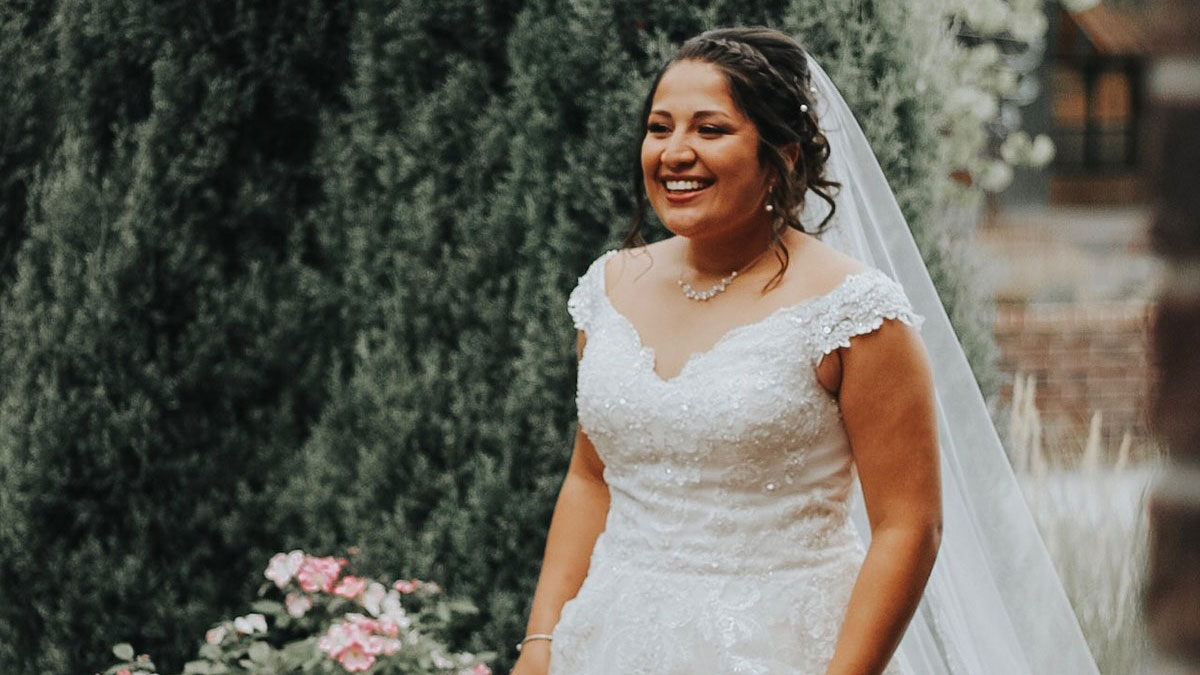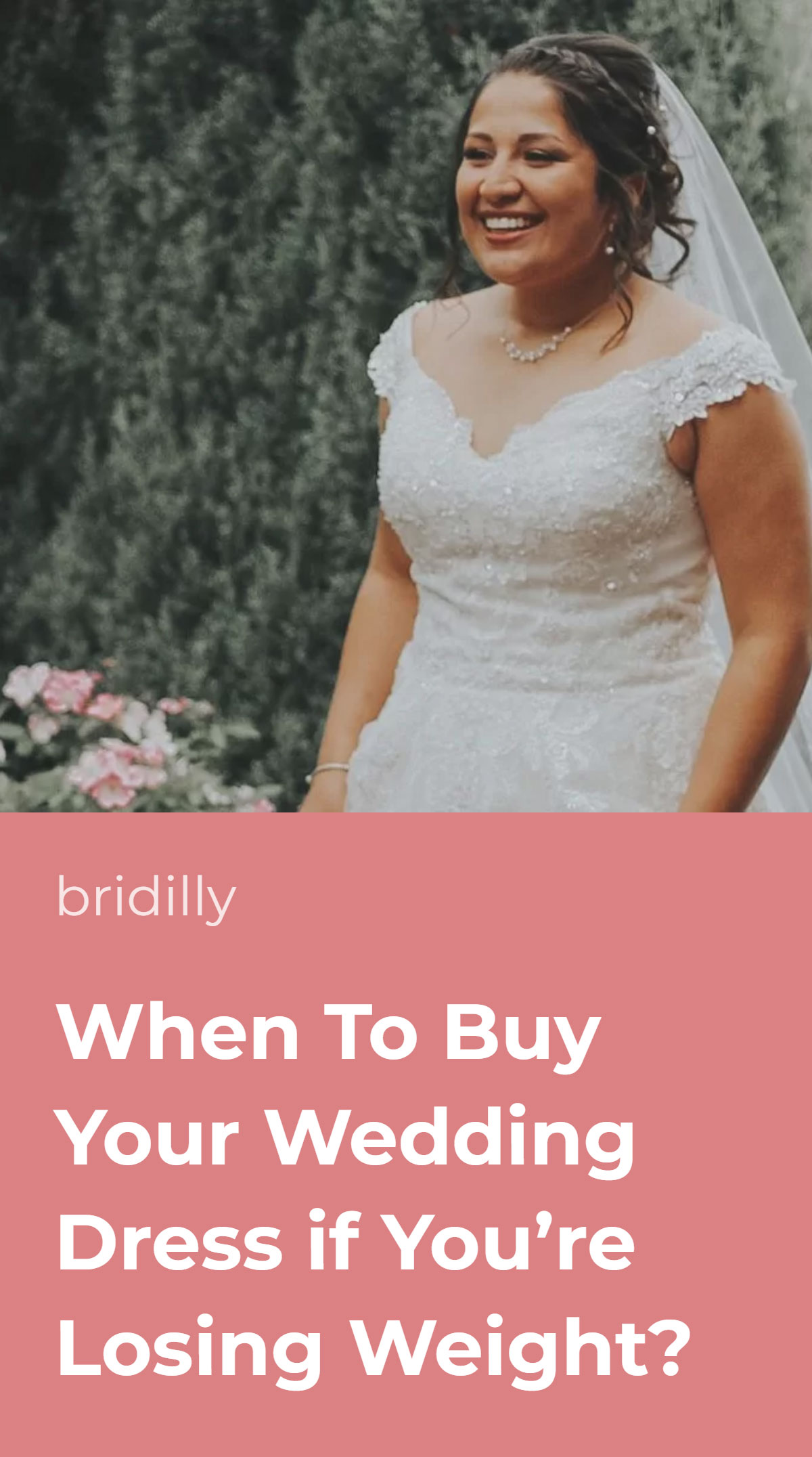One of the trickiest yet common questions among brides is when to buy a wedding dress if losing weight.
Each woman wants to look her best on her wedding day, and for many, this means getting a supermodel’s body.
The wedding planning timeline is already intricate enough, and weight loss complicates it even further – especially if you have a few dozen of pounds to lose.
However, getting a gown that fits you flawlessly isn’t impossible if you follow certain wedding dress shopping rules. Don’t order a smaller size, choose the dress style early, and consider the alteration timeline.
While reaching your goal is important, don’t neglect your mental state. The weight loss journey doesn’t always go as planned, but you’ll be the most beautiful woman at your wedding regardless of your weight.
Table of Contents [show]
Custom-Made Dresses
The first point to consider in deciding when to buy a wedding dress if losing weight is whether you want a custom-made dress or a ready-made one.
Bespoke wedding dresses have numerous advantages: they’re one-of-a-kind, perfectly tailored for you, and you get to choose every minor detail. However, custom wedding dresses take time to sew.
The average bespoke wedding dress sewing period is 3-6 months, depending on the designer’s pipeline of work and the dress style.
That being said, some designers can make you a dress in under a month, which would be a perfect option.
Either way, order your dress early but mention your weight loss to the designer. This will let them plan which dress elements to make earlier and which to leave for a later period to minimize the alterations.
Avoid ordering bespoke dresses online. You’ll need to attend multiple fittings and constantly keep in touch with the designer. If you can’t find anyone in your town, at least ensure you can get to them by car or bus.
Ready-Made Dresses
The best time to buy a wedding dress that’s been pre-made by standard sizing chart is 8-5 months before the event. This will ensure you have time for alterations and fittings but also let you closely predict your final size.
If you want to avoid alterations, you may risk shopping for the dress about a month prior to the wedding. In this case, your options will be limited to dresses available in the bridal salon that already fit you perfectly.
Losing Up To 25 Pounds
Your wedding dress shopping and alteration timeline also depends on how much weight you’ve left to lose. If you’re planning to lose up to 25 pounds, shopping for a dress is much easier than if you plan to lose over 30 pounds.
As a rule of thumb, 25 pounds equal one or two clothing sizes. Thus, you can safely get a dress of your current size.
Of course, you will need a tailor to fit it for your final size before the wedding, but it shouldn’t take too long since the difference isn’t significant.
Alternatively, you can take a dress one size smaller – but not two sizes smaller.
Firstly, even if the smaller dress size will fit your final weight, you may still need some alterations to fit it for your unique body shape. Secondly, the weight loss journey may not go a planned.
Many wedding dress manufacturers add inserts in their dresses that can be taken out to make the garment a size larger. But this won’t work if you need to make the dress two sizes bigger, so don’t go down too much.
Losing Over 25 Pounds
If you’re losing over 25 pounds, the wedding dress shopping timeline may get tricky. If your wedding is about a year away and you need to lose 40 pounds, don’t rush with the dress – wait until you have under 20 pounds to lose.
However, don’t buy it too late since you will need some alterations. If your wedding is in under six months, order your current size, even if you have plenty of pounds to go.
Health experts recommend losing 1-2 pounds weekly, so it typically takes 15-30 weeks to lose 30 pounds. There’s no reason to risk your health to reach the desired weight for your wedding.
Meanwhile, taking a dress one or two sizes in is much easier than taking it out. Alterations usually take several months, so don’t postpone the shopping.
Choose the Design Early
If your weight changes, there’s no sense in buying your wedding dress early. However, this doesn’t mean that you can’t pick the design before you head to the store.
Start researching popular wedding dress silhouettes and styles about a year in advance.
Brides often get overwhelmed by the variety of options and have trouble picking their favorites, so wedding dress shopping tends to take more time than any other.
At first, you may want to get every dress you see or not like any of them. Your goal is to pass this stressful phase early.
Then, you’ll have enough time to consider your personal style, your body shape, the season, and other practical factors.
Most factors, such as the weather or your style preferences, won’t change with you losing weight. However, remember that bodies can change drastically even after a relatively minor weight loss.
You may think that mermaid dresses only suit brides with model bodies and hesitate to get one even though it’s your favorite style. Avoid focusing on your current weight – consider your goal weight instead.
When you reach that goal weight, you’ll be able to wear dress styles you couldn’t even imagine yourself wearing now. It’s not like only slim women can wear certain silhouettes – it’s about your confidence and self-esteem.
In other words, don’t reject wedding dress styles only because you wouldn’t wear such today. Follow your heart and keep in mind that you’ll have a different weight on your wedding day.
At the same time, remember that your body shape is unlikely to change.
If you currently have an inverted triangle body shape, don’t expect it to turn into a pear shape after weight loss. And different body shapes require different silhouettes.
Visiting a bridal salon to try on different styles is a good idea. However, brides losing weight often are overly critical of themselves. There is no need for dressing room drama – that’s mentally destructive and simply unhelpful.
Remember that you’re beautiful the way you are and will look even better at your wedding. Avoid trying on dresses of smaller sizes – instead, try on your current size and focus solely on the style.
Don’t Order Too Small Size
One of the most common mistakes in wedding dress shopping is buying an overly small size as a motivation. This may motivate you to lose weight, but not always in a good sense.
There’s a difference between positive motivation that is meant to support you in achieving your dreams and moral pressure that only makes you more stressed and obliged to reach your goals at any cost.
A wedding dress three sizes smaller than your current weight hanging in your wardrobe may make you anxious. You may be afraid not to lose the weight on time following your current plan and turn to extreme methods instead.
And if you fail to reach the desired weight for your wedding day (a possibility you should never neglect), you will either have to make significant wedding dress alterations or get a new one.
Either way, ordering a smaller size means stress, additional expenses, and lost time. Overall, it’s merely a way to get an eating disorder than positive motivation.
Don’t Neglect Fittings
As a rule of thumb, brides need at least three wedding dress fittings before the wedding. But if you’re losing weight, you may need even more to ensure the dress fits properly. Ideally, schedule wedding dress fittings every 2-4 weeks.
Never neglect fittings, even if you don’t notice major changes in your appearance. You don’t want to come to your final fitting a week before the event to find out that you’re drowning in a dress that used to be small for you.
Fittings ensure that your seamstress has enough time to make alterations if needed and that you don’t lose too much weight. They also help to choose the best suitable accessories, hairstyle, and makeup, though that’s unrelated to weight loss.
Alterations
Regardless of how much weight you wish to lose, the latest wedding dress shopping date is five months before the event. And if you’re ordering your wedding dress online, get it no later than eight months in advance.
Nearly all wedding dresses need to be altered to fit you flawlessly – some more, some less. Even if the size is correct, you may need to change the sleeve and hem length, add a train loop, or take in the waist slightly.
Wedding dress alteration is closely tied with fittings. Your final fitting will happen 2-3 weeks prior to the wedding to ensure your seamstress has time to make the last alterations.
Don’t lose any weight between your final fitting and your wedding day.




















No Comments Add one
Leave a Comment